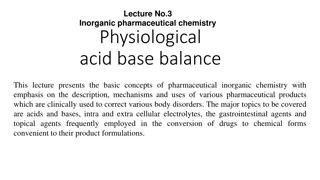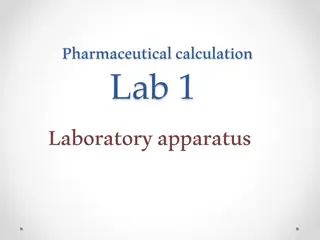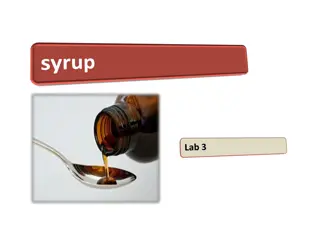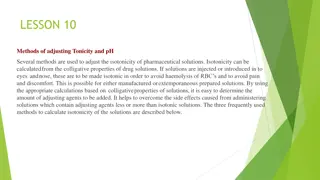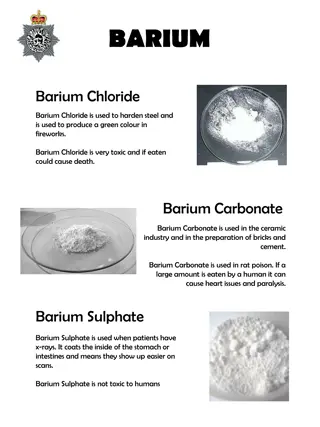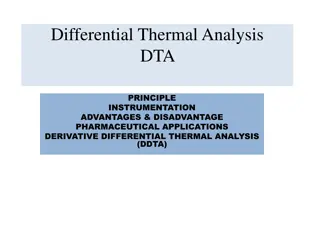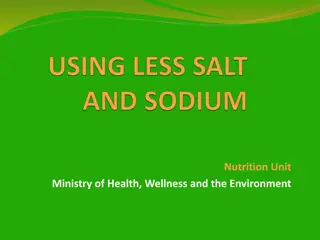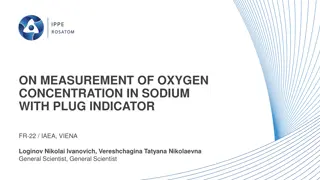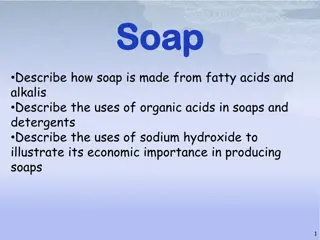Sodium Benzoate: Properties, Applications, and Pharmaceutical Uses
Sodium benzoate is a white crystalline powder with various physical and chemical properties. It is commonly used as a preservative in pharmaceutical formulations, cough preparations, and cosmetic products. Additionally, it has pharmaceutical applications in treating urea cycle disorders and schizophrenia. The chemical principle involves its reaction with substances like ascorbic acid and hydrochloric acid. A typical procedure involving titration with HCl can be followed for its analysis.
Download Presentation

Please find below an Image/Link to download the presentation.
The content on the website is provided AS IS for your information and personal use only. It may not be sold, licensed, or shared on other websites without obtaining consent from the author.If you encounter any issues during the download, it is possible that the publisher has removed the file from their server.
You are allowed to download the files provided on this website for personal or commercial use, subject to the condition that they are used lawfully. All files are the property of their respective owners.
The content on the website is provided AS IS for your information and personal use only. It may not be sold, licensed, or shared on other websites without obtaining consent from the author.
E N D
Presentation Transcript
Introduction Physical properties Chemical properties Pharmaceutical application Chemical principle Procedure Calculation
INTRODUCTION : Sodium benzoate has the chemical formula C7H5O2Na with Mwt. 144.1, It is the sodium salt of benzoic acid and exists in this form when dissolved in water.
It can be produced by the neutralization of benzoic acid with sodium hydroxide. Sodium benzoate can also be prepared by adding benzoic acid to a hot concentrated solution of sodium bicarbonate until effervescence ceases. The solution is then evaporated, Cooled and allowed to crystallize or evaporate to dryness, and then granulated. C6H5COOH + NaOH C6H5COONa + H2O C6H5COOH + NaHCO3 C6H5COONa + H2CO3
Physical properties 1- It is a white crystalline powder. 2-Density (1.44). 3- Melting point >300 . 4- Odorless compound that has a sweet. 5-Soluble in water (1gm/ 2mL water).
Chemical properties 1-In combination with ascorbic acid (vitamin C) sodium benzoate and potassium benzoate form benzene, most beverages that contained both ascorbic acid and benzoate had benzene levels that were below those considered dangerous for consumption by the World Health Organization (5 ppb), Heat and light can increase the rate at which benzene is formed. 2- Sodium benzoate is heated with soda-lime and when it gets decarboxylated (removal of carbon dioxide) benzene is obtained. 3- Sodium benzoate reacts with hydrochloric acid to produce benzoic acid. C6H5COONa + HCl NaCl + C6H5COOH
Pharmaceutical application 1- Sodium benzoate has antibacterial and antifungal properties and uses as preservative in pharmaceutical formulation including oral preparation in concentrations up to 0.5 %. It is also a common ingredient of cough preparations. 2- Sodium benzoate is used as a treatment for urea cycle disorders due to its ability to bind amino acids. This leads to excretion of these amino acids and a decrease in ammonia levels. 3- Sodium benzoate may be uses on therapy of schizophrenia. 4-Sodium benzoate is use in cosmetic products like mouthwash, toothpaste, deodorant, lotion, and shampoo.
1- Fill the burette with N/2 HCl . 2- Put 10 ml of an unknown sample of sodium benzoate solution in a clean conical flask. 3- Add 25 ml of DW and 15 ml of ether. 4- Add 6 drops of bromophenol blue. 5- Start titration by adding HCl drop wise with shaking the aqueous and ethereal layers until a light green color persists in aqueous layer.
1- Calculate the concentration of S.B.). 2- Calculate the quantity of sodium benzoate in your sample.



